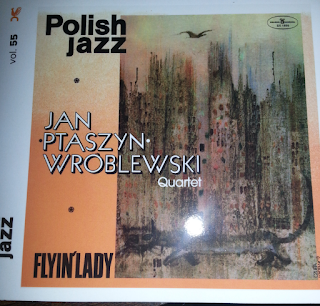Reissue: Flyin’ Lady – Jan 'Ptaszyn' Wroblewski Quartet
Jazz has been an international music for almost as long as it’s been in existence, thanks in part to American GIs who took their 78 rpm records overseas and shared them with the locals. One particularly strong jazz scene that isn’t well enough known to American fans developed in Poland. From the 1940s to the present day, a large number of Polish musicians have embraced jazz as their art of choice. And few have shone as brightly as tenor saxophonist Jan “Ptaszyn” Wroblewski.
Early in his career, the gifted Wroblewski was dubbed “Ptak” (Bird) and later “Ptaszyn” (Little Bird) as a spiritual link to Charlie Parker. However, the Polish marvel soon developed a signature style on saxophone, becoming one of the most identifiable and prolific musicians in European jazz. While he does lean in the direction of Sonny Rollins at times, tonewise and in his flow of ideas, Ptaszyn is his own bird.
His journey in the public eye began with an appearance at the 1958 Newport Jazz Festival as part of the International Youth Band, directed by Marshall Brown. The ensemble drew young players from all over the globe: Wroblewski, Hungarian guitarist Gabor Szabo, German trombonist Albert Mangelsdorff, Swiss pianist George Gruntz, Yugoslav trumpeter Dusko Goykovic, and British baritone saxophonist Ronnie Ross were among the bright youth who were about to set off on strong, enduring careers in jazz. They learned from their American mentors and from each other, taking that knowledge and experience back to enrich the jazz legacies of their homelands (well, except for Szabo, who was already at Berklee and stuck around the U.S. for most of his life. But that’s a different post...)
Above:
Four members of the 1958 Newport International Youth Band. L-R: altoist Hans
Salomon; tenorist Bernt Rosengren; tenorist Jan Wroblewski; trombonist Albert
Mangelsdorff.
In August 1978 the quartet recorded one of Wroblewski’s most acclaimed albums, Flyin’ Lady (released as No. 55 in a long series from Polish Jazz Records). Inarguably modern and yet accessible to even casual jazz fans, Flyin’ Lady became very popular even as Wroblewski himself had doubts about its quality. His apprehension was misguided; this is a tremendous performance, start to finish.
The 2017 reissue of Flyin' Lady by Polskie Nagrania/Warner Music Poland is not a remaster, simply a return of a classic to the marketplace. No bonus tracks, no tweaking of the mix, just a nice, clean presentation of a tight ensemble of veterans doing what they were born to do. The recording might be a little heavy on the mid-range for some tastes, but to my ears it brings out the warmth and strength of Wroblewski’s tone.
The six compositions by Wroblewski seem crafted with this particular ensemble in mind, and the four blend together seamlessly at times. The album leads off with “Pastuszek Stomp” (Little Shepherd Stomp), a hard-swinging waltz buoyed by Bliziński’s bell-like chords. At times the guitarist almost sounds like an electric piano, and he substitutes perfectly well in the spot where a keyboard player might normally be. Wroblewski’s solo is energetic, riding a line somewhere between Rollins and Coltrane as he explores every crevice of the harmonic structure. Bliziński’s solo is exceedingly hip, bouncing between those warm block chords and fleet-fingered single-note runs. Rek and Dabrowski are ideal anchors, clearly listening to one another and supporting the sax and guitar as needed from moment to moment.
“Grzmot nad ranem” (Morning Thunder) ups the swing quotient, and Dabrowski positively shines here. While Bliziński ‘s intro to “Bossa Nostra” sounds straight out of Rio, the quartet appropriately reshapes the form into something of their own. This is a lovely, catchy piece that will linger in your mind for hours.
“Pani Ptakowa” (Flyin’ Lady, the title track) is dedicated to Wroblewski’s wife. He begins unaccompanied on a gorgeous cadenza, then the ensemble glides underneath him with ringing chords and soft brush work. Warm and lovely. Then the quartet immediately shifts gears into a rocking mode on “Dlaczego małpa …” (translated as “Why the monkey…” on the liner notes, although the full title is “Why the monkey pisses into the beer.” There’s a satisfactorily goofy explanation in the liner notes.) Dabrowski rides a hard backbeat as the sax and guitar flit between 4/4 and 3/4 on the funky melody. The album closes with “Klichec chechcioł dana”, inspired by both Polish folk music and the relaxed vibrancy of Sonny Rollins. Unusual and pretty, the tune is a fair summary of the Wroblewski aesthetic: authentically Polish in spirit, yet true to both the tradition and outward vision of jazz.
As of this writing, Jan "Ptaszyn" Wroblewski, the grand old man of Polish jazz, is still actively performing at the age of 82. He continues to draw from a deep well of past experiences and compositions, inspiring new generations in his wake. This welcome reissue from one of his classic ensembles is a fine continuance of his legacy.




Comments
Post a Comment